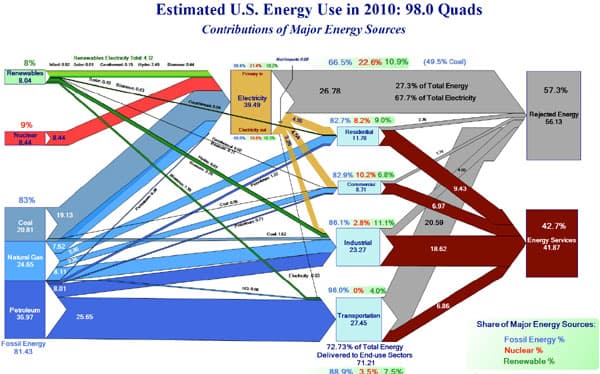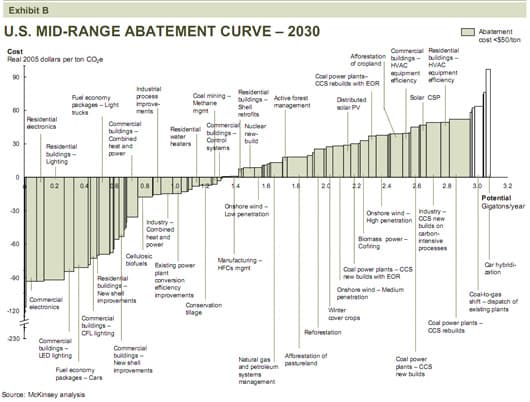Strategies for future Energy
One of the activities required will be to have my students to watch the TED debate on nuclear energy sources verse green energy, solar and wind power. 12 TED (Technology Entertainment and Design) is a global set of conferences curated by the American private non-profit Sapling Foundation, TED talks are devoted to "ideas worth spreading." 13 In this debate both sides make a powerful case for each energy alternative my students will gain insight into the difficulty in making energy choices and the advantages and disadvantage.
First, lets look at how the United States meets its energy needs today. Below is the sankey diagram for the United States energy supply for 2010; it was prepared by Eric Shuster 14. It represents the various sources of energy on the left. The energy uses in the middle and the percentage of useful energy on the right. In 2010, the US used 98 quads or quadrillion BTUs of energy, which is 103,475,260,000 gigajoules of energy. That is equivalent to 331 gigajoules per person per year or 12kW per person. 15 I am going to ask my students to calculate how many times they would have to climb to the top of the Empire State building to perform and equivalent amount of work to their average daily energy use. The answer is approximately 3900 times to the 86 th floor observation level.

A study and class discussion of this one diagram could cover several class periods but I will have to limit it to stay within the scope of other parts of my curriculum. The first point to discuss is the amount of rejected energy compared to useful energy. The discussion will be scaffold by questioning such as how can we decrease rejected energy into useful energy? How can we reduce the dependence on oil by changing the fuel used in automobiles? My students need to understand that a change in fuel used in automobiles will not fix all future energy problems such as carbon dioxide emission because transportation of all kinds only account for 28% of our energy use, industry account for 23%, commercial and residential combined 20% and 30% of the energy is rejected as waste heat. In addition, the predict US energy sankey diagram for 2025 is in Appendix 3 along with world oil consumption and carbon dioxide production diagrams 16.
Global Energy Commission
The capstone project for my curriculum unit will be the creation of the Global Energy Commission (GEC). The commission consists of energy leaders from the eight industrial countries currently in the G8, the informal group of advanced industrialized economies, and six emerging market economies namely China, India, Brazil, South Africa and Mexico. Each student will be assigned as the leader of one country; they will be responsible for developing a twenty-five year energy blueprint for their country. The Global Energy Commission will then have their annual conference and each nation will have to present and defend their energy policy to the commission leadership. Their energy plan must address and try and answer the following questions: Where will energy in your region come from? How will it be used? What will it cost? And what are the environmental impacts of your choice? How will you manage the risks of your choices? Now, I know if any high-school student could answer these questions then there would not be an energy problem but the outcome of this panel is to explore the option of energy supply and demand. How these choices effect the economic and environmental implication. Each country in the world has different choices to from the source to the disposal. This is perfect forum to discuss personal choice in limiting energy use because energy conservation is one method to meet the future energy demands.
To frame my students thoughts on how to develop an energy policy to meet their energy needs for the next 25 year I will have my students review the most recent International Energy Agency, IEA, world energy outlook reports and fact sheet. 17 The World Energy Council has "Survey of Energy Resources" which lists the energy resources available in each country in the world. 18 The two major ideas they must meet is Energy Security and Environmental impact. Energy security is the country must be energy independent or self sufficient, if their source of energy is imported then their source of energy is not secure and can affect economics and world safety. Students must use the natural resource of their region, no solar power in the northern latitudes and no biomass if your country has little land mass. Students must address energy security. Students must also address environmental impact from the use of fossil fuels and nuclear waste. I want students to come to one conclusion that conservation in all forms meets both security and environmental issues.
To help student meet environmental issues students will be given the McKinsey analysis of the cost per ton of carbon dioxide produced for 2030. 19 The diagram shows the research in the cost of reducing carbon emission. It has two parts, the downward bars are actions that are profitable they make money while reducing carbon emission and energy use. The upward bars present ways to reduce carbon dioxide that will cost money. This includes generation methods that are more expensive than coal but do not emit carbon, such as nuclear, solar, and wind. It also includes carbon capture and sequestration (CCS). 20

Students will have to strike a balance between environmental impact in the form of global warming and energy security and present their ideas to solve the energy crisis to me and the other students that form the Global Energy Council. I can not wait to see their presentations and how creative they can be in solving the problem of economical, safe, clean energy.

Comments: